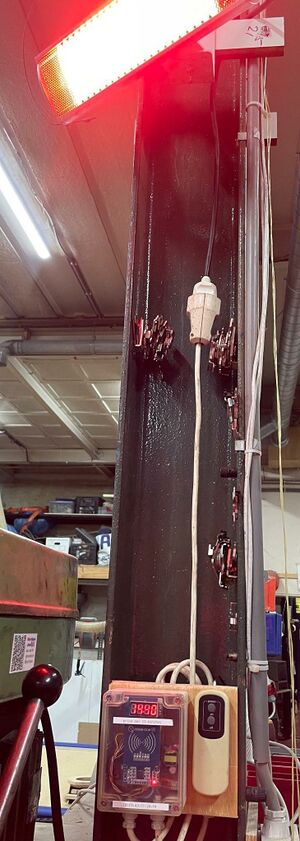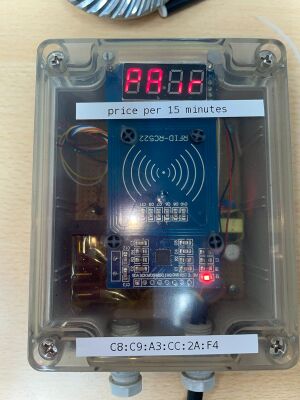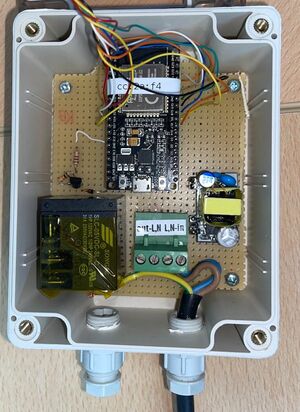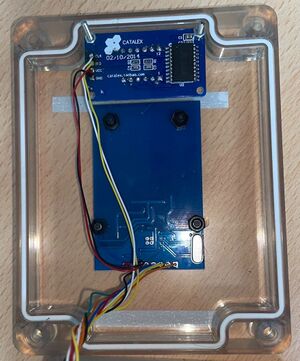Node Spot Heating: verschil tussen versies
(→Bill of materials) |
(→What does it do) |
||
| Regel 13: | Regel 13: | ||
Once you've swiped - the display changes from the price to a countdown timer; starting at 15:00. | Once you've swiped - the display changes from the price to a countdown timer; starting at 15:00. | ||
| − | + | At this point you can use the remote control to switch the actual heater. | |
| + | |||
| + | The box then start counting down; showing every second to 14:59, 14:58 and so on. During this time the heating is on. Once it reaches 00:00 - the heating switches off. | ||
You can swipe at any time - and if your payment clears; you simply get another 15 minutes added to the `on time' counter. | You can swipe at any time - and if your payment clears; you simply get another 15 minutes added to the `on time' counter. | ||
Versie van 27 sep 2022 om 19:31
Node for paying for spot heating in the Metal area (the thing `high up').
Inhoud
[verbergen]What does it do
The display normally displace a static price. The price for 15 minutes of heating.
Swipe your door tag just once to get 15 minutes of heating.
Once you've swiped - the display changes from the price to a countdown timer; starting at 15:00.
At this point you can use the remote control to switch the actual heater.
The box then start counting down; showing every second to 14:59, 14:58 and so on. During this time the heating is on. Once it reaches 00:00 - the heating switches off.
You can swipe at any time - and if your payment clears; you simply get another 15 minutes added to the `on time' counter.
Hardware vervangen/repareren
See SpaceTegoed for technical information, Payment and Paring REST protocol for the protocol and [github for code]. De node is een variant van de Payment Terminal with 4 seven segment displays - maar heeft een extra relay op pin 12 met een NPN register en 10k pull down / 1k feed.
Note that you *must* unseat the power connector before plugging in the USB (or take out the ESP32). For this reason; the green powerplug has been mounted in such a way that it is almost impossible to plug in the USB without unplugging that connector (i.e. as a gentle reminder). Once it is programmed for the first time - it can be reprogrammed over OTA; and does not need the USB anymore. You can `see' the serial output by telnet-ing in (see below), watching MQTT, the build in webserver, etc.
Important for maintainers
The descriptive name of the node in the CRM needs to start with the minutes of heating provided; as digitas; as the very first thing in the descriptive text. E.g. "15 minutes of heating" or "15 minuutjes warmte". As the software picks up this as the countdown value (together with the price). It interprets this as minutes.
If the descriptive text does not start with a (non zero) number -- the unit becomes a normal payment terminal. That does not count down.
Code nu at https://github.com/dirkx/makerspaceleiden-payment-node-7segments/tree/COUNTDOWN - to be merged to the main tree once tested.
known bugs in version 1.07 /CC2AF4
Pin 25/26 swappedPSU a bit bare, top relay needs captontape- Needs grounding
- Glands may be too small
- No LED on relay
Versions build
Node Spot Heating
- Wifi-Mac address ends with
CC2AF4
Current software: https://github.com/dirkx/makerspaceleiden-payment-node-7segments/releases/tag/v1.07
Trouble shooting
It is possible to 'telnet' into these units (on the normal telnet port #23) and see what normally would come out of the serial port. The units also sent their logging to syslog (to the spaceserver, 192.168.6.1).
Check the firewall, use a [MDNS] [resolver] (or simply the Arduino IDE) to discover their IP address. You can do this from the RaspPi next to the VinylCutter / Vinylsnijder. The most recent IP address is shown below. Update this if you replace the hardware; or if you find it has moved IP address.
| MAC | Versie | Mac address | IP address |
|---|---|---|---|
| NodeSpotHeating | 1.07 | C8:C9:A3:CC:2A:F4 | 192.168.6.??? |
Version deployed as of September 2022: https://github.com/dirkx/makerspaceleiden-payment-node-7segments/releases/tag/v1.06
A typical session looks like:
$ telnet 10.13.0.241 23 4x7-F1-05-430fe4 Serial connected 3C:71:BF:43:0F:E4 Good scan Payment completed successfully. Wed Nov 3 19:02:11 Heap: 181 Kb
Any error message (post joining the Wifi network) will show up here. If the issue is prior to joining WiFi - you will have to connect a USB cable (Baudrate 115200, 8N1). The Raspi has the right drivers installed.
Furthermore - if you connect to space.makerspaceleiden.nl via MQTT - then you can also see the output:
TOPIC: ac/log/tft-1.04-cbb67c
NodeSpotHeating {
"rfid_scans": 0,
"rfid_misses": 0,
"ota": true,
"state": 3,
"IP_address": "192.168.6.200",
"Mac_address": "C8:C9:A3:CB:B6:7C",
"Paid": 0,
"Version": "1.04",
"Firmware": "tft-1.04-cbb67c",
"heap": 139667
}
Display messages
- During startup
F X-YY- version number firmware during booting.CONN- connecting to WiFiNTP- getting the timeF CA- Fetching the Certificate AuthorityF PL- Fetching the price listFAIL- failed to connect to WiFi; will reboot.any error message- scrolling error message & after which either reboot or hang if it unrecoverable.
- At the end of startup (from this point onwards OTA is possible).
----- fully started up; but have not yet gotten the pricelistno prices- price list could not be fetched. Will retry for a few minutes every 15 seconds; then reboot.
- In normal payment mode
X.YY- price to pay when you swipe. There is no leading zero.[--]- in the process of payingFAIL- payment failedpaid- you have paidMM:SS-- a minute and second countdown. Once at zero - the heating switches off. There is always a leading zero.any error message- scrolling error message.FAIL -1- netwerk/wifi error. Powercyle de unit.FAIL -4- netwerk/wifi error. Powercyle de unit.FAIL 40XGebruik je een geldige tag ?FAIL 500Error op de server; mail noc@.
- During Over the Air reprogramming.
PROG- start of OTA updateF XX- OTA; uploading new firmware; XX is the percentage fetchedDONE- successful end of OTA. Unit will reboot.any error message- scrolling error message & after which the device will switch back to the old/current firmwareFO:AF- OTA authentication failedFO:BF- OTA begin failedFO:CF- OTA connect failedFO:RF- OTA receive failedFO:EF- OTA end failedFO:OF- OTA 'other' failure
- During initial pairing / post an OTA
REGRegistering with the serverPAIRrequesting to pair; swipe an admin tag.any error message- scrolling error message.
Code is at https://github.com/MakerspaceLeiden/makerspaceleiden-payment-node-7segments.
Bill of materials
Materialen; duurste onderdelen eerst:
- ESP32: 7 euro - https://www.amazon.nl/AZDelivery-Development-opvolger-compatibel-Inclusief/dp/B074RG86SR/ref=sr_1_9
- PVC Doosje - wat groter dan normaal; 100x90x60 of zo.
- 7 segment display: 2.50 euro - https://www.amazon.nl/Youmile-Display-Gemeenschappelijke-Digitale-Man-vrouw/dp/B082193P1V/ref=sr_1_33
- 1 RFID reader; ~2.50 Euro; (https://www.amazon.nl/gp/product/B074S9FZC5)
- AC/5V transformer: 1.00 euro - https://www.aliexpress.com/item/33012749903.html
- 1 relays - 5 Volt, voor 230 VAC / 30 Ampere, lots of watt (herkomst https://www.baco-army-goods.nl - prijs onbekend)
- 2 doorvoerwartel; 12mm: 0.35 euro (voorraad space, https://www.aliexpress.com/item/32866592761.html)
- restje print (https://www.baco-army-goods.nl/experimenteer-print-eilanden.html)
- stukjes dik koper draad (VD draad) om het 220v pad via relays de heater wat op te dikken.
- 10k weerstand 1/8 watt ((https://www.baco-army-goods.nl/)
- 1k weerstand 1/8 watt ((https://www.baco-army-goods.nl/)
- BC5476 transistor, NPN (https://www.bitsandparts.nl/Transistor-BC547-NPN-45V-0-1A-p115143)
- printconnector met steker, 4 pins
- kroonsteentje voor aarde.
- netsnoer - weggooikast space
- draadjes - electronica hoek
- 4x korte nylon boutjes voor de RFID lezer met moer (ook nylon ivm radio interference)
- twee dunne boutjes/moertjes voor het display (1.5mm)
- epoxy voor lijmen boutjes aan doorzichtig frontje
- labels uit de label printer
Totaal: < 20 euro; 60 minuten solderen/assemblage en wachten tot de epoxy droog is.
Compileren software
- Installeer een recente versie van [[1]].
- Installeer een stable versie van de SDK voor de ESP32 volgens https://docs.espressif.com/projects/arduino-esp32/en/latest/installing.html
- Selecteer in tools het platform ESP32 en dan het board dat je gebruikt (WRover, Devkit)
- Installeer via de 'Library' optie de bibliotheken MFRC522-spi-i2c-uart-async, TM1637TinyDisplay en Arduino_JSON
- Haal een git/zip versie op van https://github.com/MakerSpaceLeiden/makerspaceleiden-payment-node-7segments/
- Zet de #defines met de netwerk namen goed. Kies een unique terminal naam.
Overleg met noc@ voor een 'bearer token' voor toegang als je de productie versie maakt.- Idem voor het OTA wachtwoord.
- Compiler & flash via serial (daarna kan het via OTA).
- Nota bene: with the cheaper boards; it may be needed to press 'BOOT' during the start of the programming.



